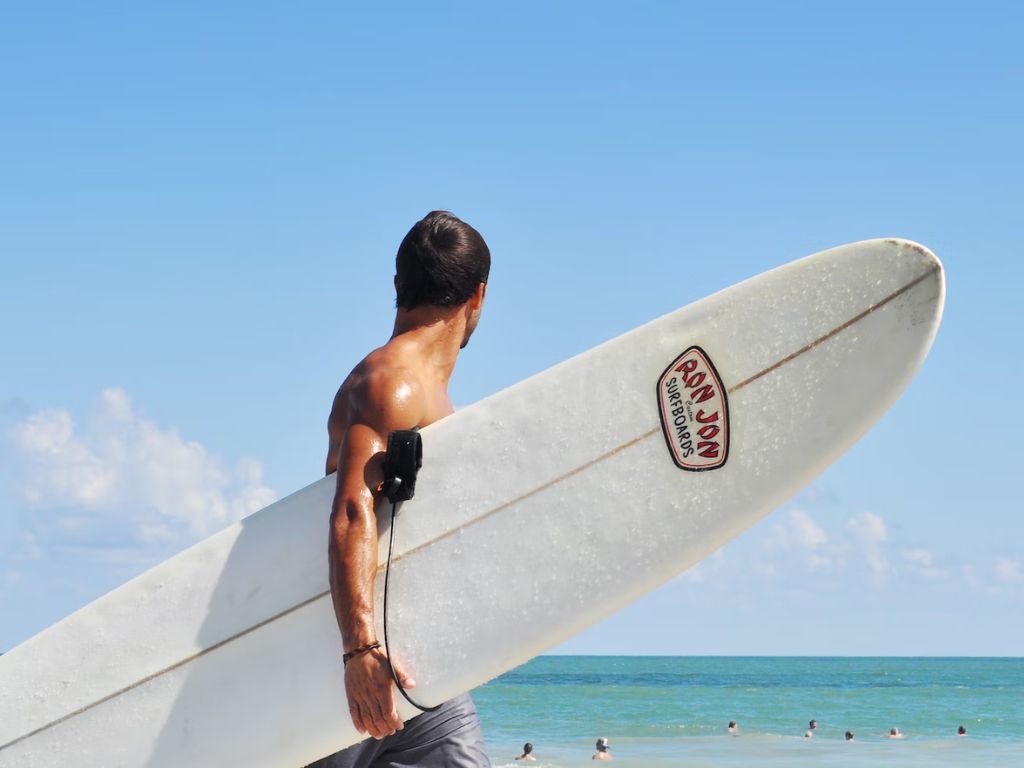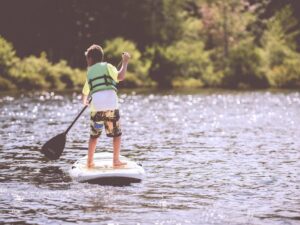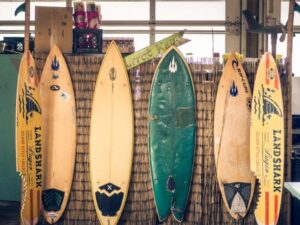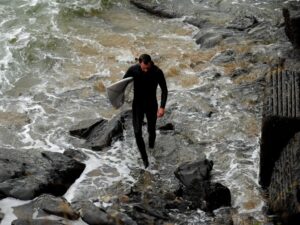Are you ready to hit the waves and catch some gnarly surf? Good, but…
Whether you’re a seasoned pro or a beginner looking to catch your first wave, choosing the right surfboard is crucial for a successful and enjoyable experience. With so many different shapes, sizes, and materials, deciding which board is best for you can be overwhelming.
Though it’s one of those things where you just buckle up and do them, choosing the right surfboard is crucial for your surfing experience. It can distinguish between catching the perfect wave and wiping it out.
Don’t worry; it’s not that hard. With some knowledge, you can choose the perfect surfboard that matches your skill level, wave conditions, and personal preferences.
A. Quick Look at Surfboard Parts & Types
To choose the right surfboard, it’s important to understand the different parts that make up a surfboard and how each part affects your surfing. Here’s a quick overview:
- Nose: The typically rounded front end helps the board cut through the water.
- Tail: The back end affects the board’s maneuverability and speed. It comes in different shapes and sizes.
- Rails: The sides of the board come in different thicknesses and shapes, which affect the board’s stability and turning ability.
- Deck: The top part of the board is where you stand. The deck is typically covered in traction pads or wax to provide grip.
- Bottom: The part that comes in contact with the water. It can be flat, concave, or have different contours, which affect the board’s speed, maneuverability, and stability.
- Fins: These are attached to the bottom of the board and affect the board’s stability, speed, and turning ability.
Understanding these parts and how they affect your surfing is crucial in choosing the right surfboard. Now, let’s get to different types of boards.
While there are many different types of surfboards, all of them are generally categorized into six types:
- Shortboards,
- Longboards,
- Funboards,
- Fish,
- Gun,
- Hybrid Boards.
I’ll discuss them in the next section, so don’t worry.
B. How to choose the right surfboard?
I have a four-step process for choosing the perfect surfboard for my need that I’ll share with you.
Step 1: Choosing the right size.
When it comes to surfboards, size matters. The right size board will make it easier for beginners to catch waves and improve their performance. And it only depends on three factors – skill level, surfer’s weight, and wave conditions.
To determine the right size for your surfboard, a general rule of thumb is to choose a board that is one to two feet taller than your height and has a volume of at least 2 liters per kilogram of your body weight.
A. Skill level: Beginners should opt for a larger board with more volume to provide extra stability and make it easier to catch waves. As you progress, you can switch to smaller boards with less volume.
B. Weight: Your weight plays an important role here. Heavier individuals require more volume and surface area to stay afloat and catch waves.
To make your lives easier, here’s a table for the board size and volume you should look for based on weight and height.
| Weight (lbs) | Height (ft) | Board Size (ft) | Board Volume (L) |
| 90-130 | 4’10”-5’2″ | 6’6″-7’0″ | 40-50 L |
| 130-160 | 5’2″-5’6″ | 7’0″-7’6″ | 50-60 L |
| 160-180 | 5’6″-5’10” | 7’2″-7’8″ | 55-65 L |
| 180-200 | 5’10”-6’2″ | 7’4″-8’0″ | 60-70 L |
| 200+ | 6’2″+ | 8’0″+ | 70+ L |
C. Wave conditions: The size and shape of the waves you’ll be surfing determine the right size board. Smaller waves require a larger board, while larger waves require a smaller board with less volume.
Step 2: Choosing the right type / shape.
A. Shortboard
The most common type of surfboard ranges from 5-7 feet long. They have pointed noses and narrow tails, which makes them fast and maneuverable.
Shortboards are designed for high-performance surfing, perfect for advanced surfers who want to ride waves with speed and power. However, they could be better for beginners because they require advanced skills and balance.
B. Longboard
They’re typically 9-10 feet long and have a rounded nose and a wide tail. Longboards are great for beginners because they’re stable and easy to paddle. They’re also good for small waves and cruising.
Longboards are perfect for beginners because they can easily paddle and catch waves. They are also great for cruising and carving because of their stable platform.
However, they are only suitable for high-performance surfing, making them suitable for advanced surfers who want to ride big waves.
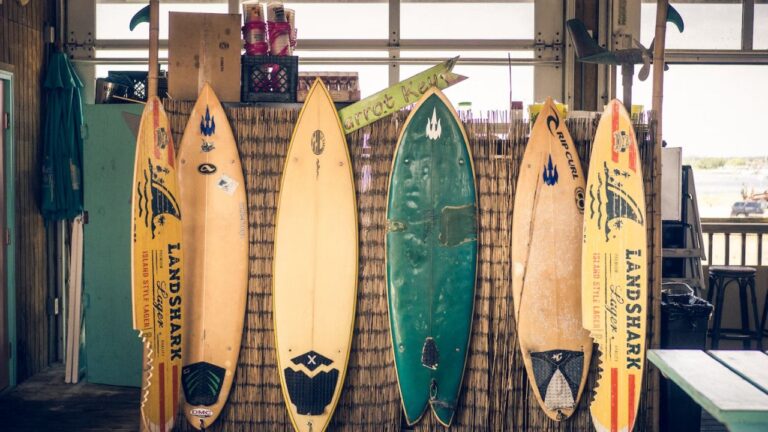
C. Fish
A fish surfboard is a shorter and wider board that ranges from 5’6″ to 6’6.” It has a rounded nose and a wide tail.
They’re designed for small to medium-sized waves and are good for beginners and experienced surfers alike. They’re known for their speed and maneuverability, which makes them a great option for surfing in crowded areas.
D. Gun
These surfboards are longer and narrower than shortboards, typically between 7-10 feet. They’re designed for big waves and are meant for experienced surfers.
Gun surfboards are more maneuverable than others but are built for speed and stability in large waves.
E. Hybrid
Hybrid surfboards combine elements of different types of surfboards.
They’re designed to be versatile and can be used in various wave conditions. They’re good for surfers who want a surfboard to do some of everything.
G. Funboard
A funboard is a hybrid surfboard ranging from 6’6″ to 8’0″. It has a rounded nose, a wide and stable body, and a round or square tail.
They’re designed to combine the stability of a longboard with the maneuverability of a shortboard, making them perfect for beginners and intermediate surfers who want to easily catch waves and practice turns and tricks.
Step 3: Choosing the right material.
The material of your surfboard can also play a significant role in your surfing experience.
A. Polyurethane (PU)
PU boards are the most common type of surfboard known for their durability and responsiveness. They are made by coating a foam core with fiberglass and resin.
More importantly, PU boards are more durable and perform better.
B. Expanded Polystyrene (EPS)
EPS boards are made from a foam core covered in epoxy resin. They are lightweight and provide excellent buoyancy, making them a popular choice for beginners.
C. Soft-top
Soft-top boards are similar to foam boards in that they are lightweight, buoyant, and easy to handle. However, they are more durable than foam boards and handle more wear and tear.
They’re ideal for beginners as they provide extra stability and are less likely to cause injury if you fall.
| Foam | Epoxy | Fiberglass |
| Ideal for beginners | Ideal for intermediate and pros | Ideal for pros and experienced surfers |
| Affordable | Expensive | Most expensive |
| Comparatively less durable | Durable | Highly durable |
Step 4: Choosing the right fins.
Fins are often the most underappreciated part of the surfboard. Simply put, you can’t slap any fin onto your board. You have four basic types – single, twin thruster, and quad.
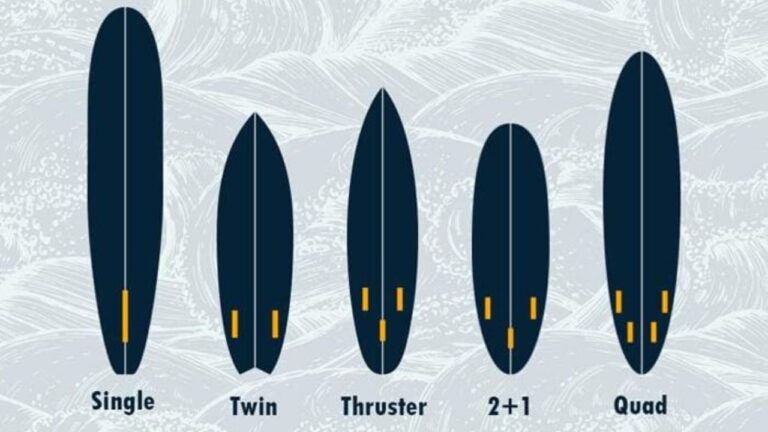
A. Single Fin
A single fin is a large fin centered at the surfboard’s tail. It’s suitable for beginners.
It provides stability and control, perfect for longboards and retro-style surfboards. However, it lacks maneuverability, making it unsuitable for high-performance surfing.
B. Twin Fin
A twin fin is a pair of smaller fins placed at the surfboard’s tail.
It provides speed and maneuverability, making it perfect for fish and retro-style surfboards. However, it needs more stability and control, making it unsuitable for surfing in big waves.
C. Thruster
A thruster is a set of three fins placed at the surfboard’s tail.
It balances speed, maneuverability, stability, and control, making it perfect for shortboards and high-performance surfing.
It’s the most common type of fin configuration used in modern surfboards.
D. Quad Fin
A quad fin is a set of four fins placed at the surfboard’s tail. It provides speed and maneuverability, perfect for surfing in smaller waves. However, it needs more stability, so I would recommend something other than for beginners.
C. Tips for Choosing Your First Surfboard
- Choose a long, thick, and wide surfboard that’ll make it easier for you to paddle and catch waves. Consider funboards or longboards, as they are ideal for beginners and are more forgiving when you make mistakes. Avoid shortboards.
- Choose a surfboard with a lot of volume so it’s easier for you to paddle and stand up on your board. Beginners should ride a surfboard that exceeds 40L of volume.
- As a beginner, the tail shape and number of fins on a surfboard do not matter. Focus on finding a beginner surfboard for a good bargain so you can start surfing regularly.
- Choose a surfboard that will work well in the surf breaks you live nearby.
D. What is the best surfboard for beginners?
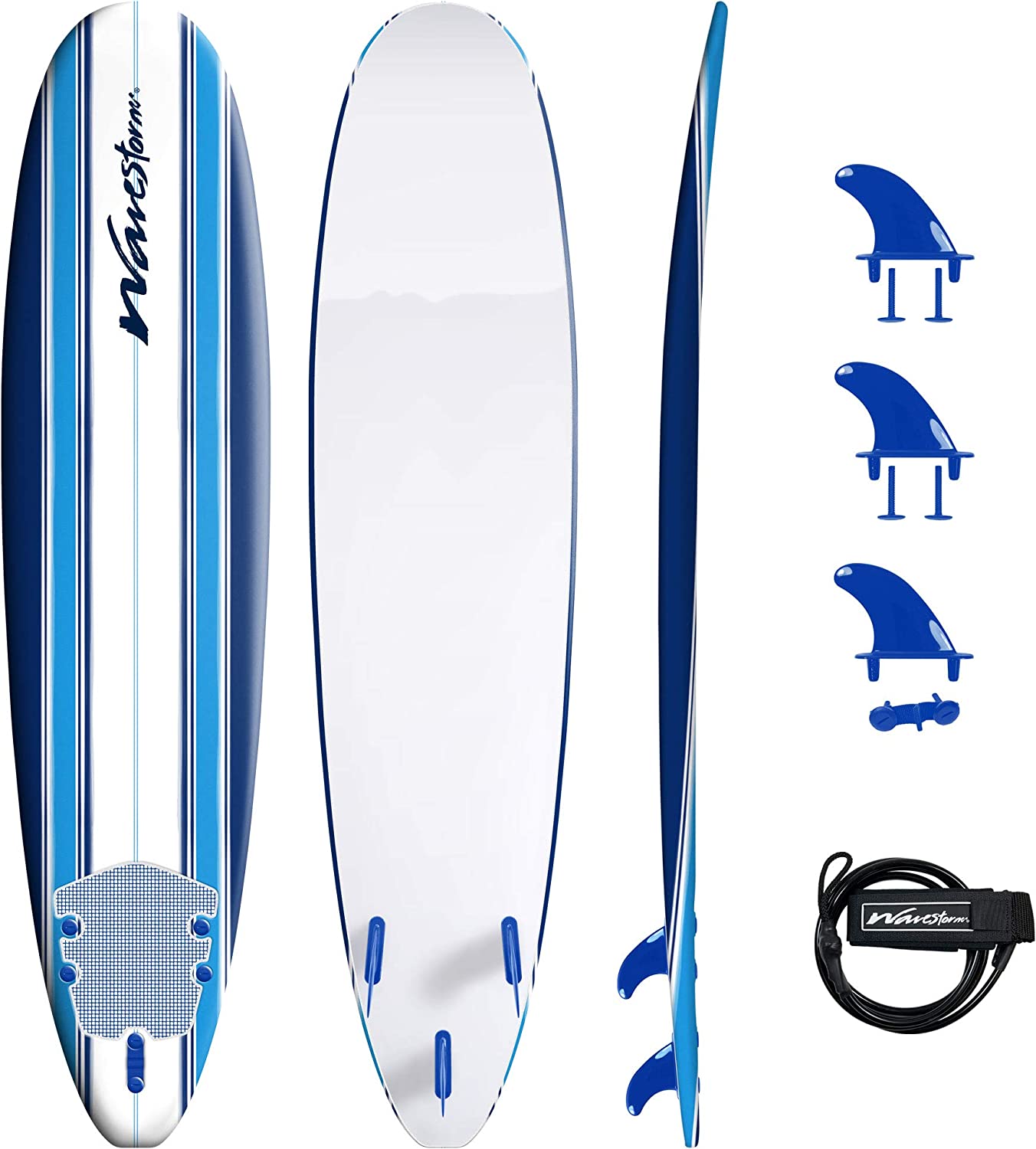
Wavestorm 8ft Classic Surfboard
Wavestorm 8ft Classic Surfboard is the best option for beginners learning surfing. This affordable and reliable surfboard is made from soft foam construction with an EPS core and 3 Stringer System. Additionally, the surfboard is very comfortable to learn to stand up on.
It’s one of the most popular boards in the US and has been consistently refined season after season to bring you the most advanced and innovative material compositions available. What makes this surfboard stand out is its easy-to-handle design and lightweight structure.
The whole mechanism makes it easy for beginners to maneuver in the water. The 8ft Classic Longboard is also one of the best-selling learn-to-surf models in the market, and it’s not hard to see why. Moreover, the board doesn’t require waxing, which is just super convenient for beginners who may not be familiar with the process.
Go ahead, catch those waves, and enjoy the thrill of surfing with this amazing beginner-friendly surfboard!
If you want more options, I have compiled separate lists of the best beginner-friendly surfboards and the best intermediate and pro-level surfboards in the US.
E. How much should I spend on the first surfboard?
The cost of a surfboard can vary greatly depending on factors such as the type of board, the quality of materials used, and the brand name.
Generally, beginners should get a surfboard in the lower to mid-range price point, which typically ranges from $200 to $500. It’s because you’ll likely be experimenting with different board sizes and shapes to find what works best for you, and investing in a top-of-the-line surfboard is necessary.
Once you’ve gained some experience and have a better idea of your preferences, you may consider investing in a higher-quality surfboard that suits your needs better. Intermediate-level surfboards can range from $500 to $1,000, while pro-level surfboards can exceed $1,000.
However, it’s important to remember that the most expensive surfboard doesn’t necessarily mean the best surfboard for you. It’s crucial to prioritize finding a surfboard that matches your skill level and goals rather than just the price tag.
One way to save money on a surfboard is to consider purchasing a used board. Many surf shops offer used boards at discounted prices, and online marketplaces such as Craigslist or Facebook Marketplace can also be great places to find used surfboards.
F. How to choose a fin size for a surfboard?
Choosing the right size fin can significantly impact your surfing experience. Here’s what you need to know to choose the right fin size for your surfboard.
1. Consider Your Surfing Ability
You’ll likely benefit from larger fins that provide more stability and control if you’re a beginner. Intermediate and advanced surfers prefer smaller fins for more maneuverability and speed.
2. Look at Your Surfboard’s Fin Setup
Different surfboard models have different fin setups, which can affect the size of the fins you choose.
Single fins, twin fins, and thruster setups require different fin sizes. Ensure you know the number and configuration of the fins your board needs before shopping.
3. Take Your Board’s Size and Volume into Account
Larger boards generally require larger fins for proper performance, while smaller boards need smaller fins. Additionally, boards with more volume may require larger fins than those with less volume.
4. Consider the Surfing Conditions
Larger fins may be more suitable if you surf in smaller, slower waves. In contrast, smaller fins may be better for faster, more powerful waves.
5. Know the Fin Size System
Fins are typically measured in inches. They’re available in sizes from 4 to 10 inches. Though, the fin size system can vary by brand and model.
Some companies use a numbered system, while others use a small, medium, and large approach.
6. Experiment and Adjust
Finally, remember that fin size is a personal preference. What works for me may work better for you. Feel free to experiment with different fin sizes and configurations until you find what works best.
It’s also worth noting that changing the size or configuration of your fins can significantly impact the performance of your surfboard, so be sure to adjust slowly and methodically.
G. Should I buy a new or used surfboard?
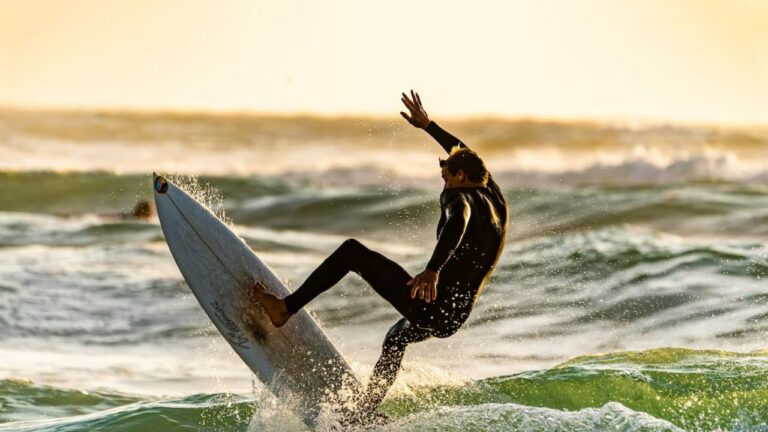
Generally, beginners should buy used surfboards to save money while experimenting with different surfboard types and sizes. Once you know your needs and surfing style, you can invest in a better, more premium board.
Buying a new surfboard means getting a mint condition board that’s never been used. However, new surfboards can be expensive, especially if you want high-quality materials or a custom design.
On the other hand, buying a used surfboard can be a more affordable option. You may find a used board in good condition for a fraction of the cost of a new one.
Additionally, buying used is more environmentally friendly, as it gives a second life to a product that might otherwise end up in a landfill.
H. What are some common mistakes people make when choosing a surfboard?
Choosing the right surfboard is crucial for any surfer, whether you’re a beginner or an experienced rider. However, even experienced surfers can make common mistakes when selecting a new surfboard.
- Buying the wrong size surfboard.
- Choosing the wrong shape.
- Neglecting the board’s volume.
- Failing to consider the surfing environment.
- Choosing the wrong material.
Expert QnA
Q. What type of surfboard is unsuitable for beginners?
A performance shortboard is the most unsuitable surfboard for a beginner. It’s the worst equipment for training and improving surf skills because it’s a short performance-focused surfboard.
In contrast, beginners require a long and wide balance-focused surfboard.
Q. What type of surfboard is best for a beginner?
For a beginner surfer, a longboard or foam board is the best. It’s due to their stability and ease of use. Longboards, typically measuring 9-10 feet, have a high volume that aids in catching waves. Meanwhile, foam boards, made of soft foam material, provide greater stability.
Q. What size surfboard should I choose?
Generally, a longer and wider surfboard is easier to catch waves with, while a shorter and narrower board allows for more maneuverability. The surfboard size you choose depends on a few factors: weight, skill level, and the type of waves you’ll surf.
Q. What's the difference between a longboard and a shortboard?
Longboards are typically longer, wider, and thicker than shortboards. They are easier to paddle and catch waves with, making them a great option for beginners.
Comparatively, shortboards are more maneuverable and designed for more experienced surfers to tackle larger, more challenging waves.
Q. What materials are surfboards made of?
Surfboards can be made of various materials, including polyurethane foam, polystyrene foam, and epoxy resin. Polyurethane foam is the traditional material used in surfboards.
In contrast, polystyrene foam and epoxy resin are newer, more eco-friendly options.
Q. Can I surf with a damaged surfboard?
Generally, you shouldn’t surf with a damaged surfboard as it could be dangerous. Even minor dings or cracks can cause water to seep into the board, affecting its buoyancy and maneuverability. It’s best to get any damages repaired before hitting the waves again.

